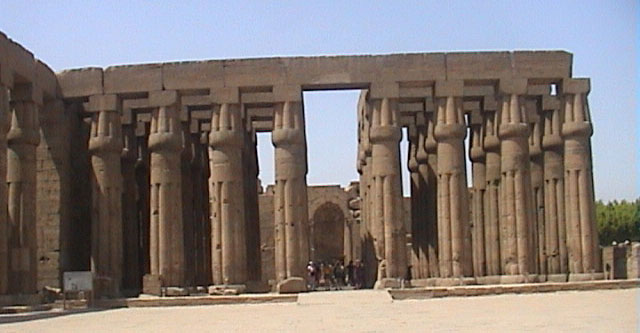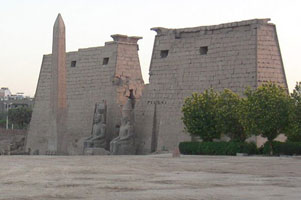Beyond the colonnade of Amenhotep III there is a further courtyard built by Amenhotep III featuring double rows of papyrus columns with barque shrines for Mut and Khonsu at the southern end. A cache of statues was discovered under the floor of this court and can now be seen in the Luxor Museum.
Decorations depict the coronation of Amenhotep III by the gods. On the south side of this courtyard a hypostyle court composed of thirty-two columns leads to the inner sanctum of the temple. To the left of the central aisle there is an altar dedicated to the Roman Emperor Constantine.

The inner sanctum is reached by a shadowy antechamber with eight columns which was used as a temple during the Roman period. Roman decorations overlay the original Egyptian carvings, but the original carvings can be seen in patches where the stucco is crumbling away. A second antechamber contains a further four columns and depictions of Amenhotep II offering incense to Amun.

Past the antechambers, there is a barque shrine built by Amenhotep III and rebuilt by Alexander the Great which would house the statue of Amun during the Opet festival. Finally, there are private chambers for the use of the three gods and the Birth Shrine of Amenhotep III in which the divine origins of the king are proclaimed. Amun takes the place of his father, Tuthmosis IV, to father the god-king with Mutemwiya (Amenhotep’s mother). Khnum makes the pharaoh on his potter’s wheel and the newborn king is presented to the gods.
History
The temple of Luxor is first mentioned on a pair of stelae dated to the twenty-second year of the reign of Ahmose I found at the Maasara quarry, to the east of Memphis. The stelae record the excavation of limestone for a serious of temples including the Luxor temple, which is referred to as the “Mansion of Amun in the Southern Sanctuary.” However, the earliest structure discovered at Luxor appears to date to the reign of Hatshepsut and Tuthmosis III. The shrine they constructed was later expanded and extensively remodelled by Ramesses II.

This was not the last building at Luxor to be extensively remodelled or dismantled. Reused blocks from structures built by Hatshepsut, Thuthmosis III, and Amenhotep II have been found at the site. Akhenaten built a sanctuary dedicated to the sun god next to the Luxor Temple but this building was destroyed by Horemheb.

Tutankhamun built extensively at Luxor, but his constructions were largely usurped by Horemheb and Ramesses II. At one time there was a chapel dedicated to Hathor (built during the 25th dynasty by Taharqa) and a colonnade built by Shabaka, but both have been destroyed. Hadrian built a small mudbrick shrine to Serapis but all that remains of this structure is a statue of Isis and some rubble.
The Romans built a fort at the site and it is thought that around 1,500 Romans were stationed there. Although it seems that the religious function of the site had largely been eclipsed by its military function and some blocks of masonry from the temple were used in the construction of military buildings, a few other Roman additions suggest that this process was not complete. A Christian basilica was added to the north east corner of the temple and later a mosque dedicated to the Muslim saint Abu’l Hagag was constructed on top of the ruins of this Christian building.
Copyright J Hill 2010